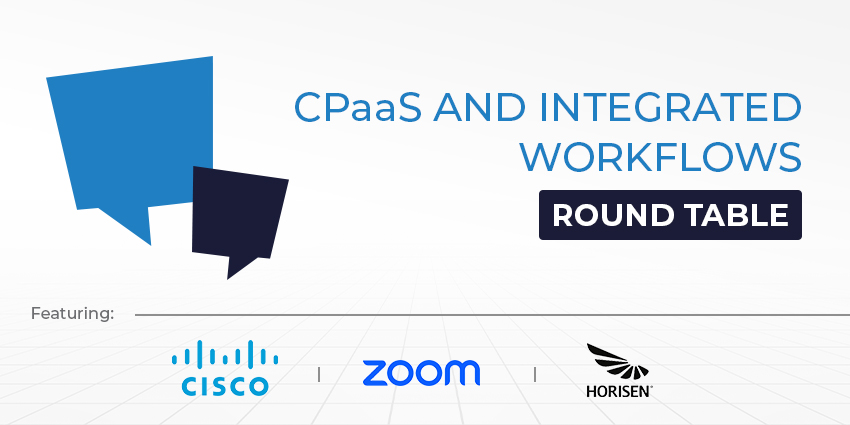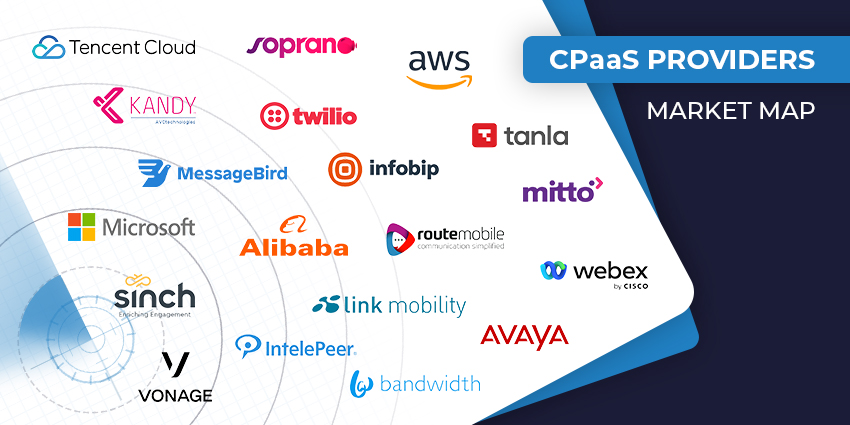Communication Platforms as a Service, or “CPaaS” technology promises companies a way to build their ideal technology stack, without the compromise. CPaaS solutions have been rapidly gaining popularity in the last couple of years, particularly as brands invest more into digital transformation.
According to IDC, the CPaaS industry will be worth around $17.7 billion by 2024, and new vendors are appearing in the market all the time. The question for many companies considering an investment in CPaaS right now is, where is the sector heading?
We spoke to industry innovators from Avaya, Anywhere365, Sinch, IntelePeer, Pexip, and Vonage, to get their opinions and insights into the CPaaS space.
What are the most significant customer trends from 2021?
Often, the easiest way to predict the future of an industry, is to look at the current trends. Throughout 2021, CPaaS has generated significant attention among companies looking to upgrade their communications tack for the new age of work. Innovative CPaaS solutions give organisations more freedom to dictate how they’re going to connect multiple tools in their tech stack. The right CPaaS ecosystem can even be the key to building a truly unified single-pane-of-glass system for comms.

Frank Fawzi, CEO for IntelePeer
IntelePeer’s CEO, Frank Fawzi told us one of the most significant customer trends impacting companies today, is the demand for more personalisation in every interaction. Businesses are having to go to greater lengths to show customers they’re valued and understood. The brands that do this effectively will gain an edge over the competition.
“Another trend that will continue to impact businesses is the customer’s growing desire for information that is accurate and timely. It shouldn’t be a struggle to research and find a product or service online and get immediate answers and support. But it often is, particularly on a company website where customer service contact information is buried deep within the site”
According to Fawzi, companies are beginning to recognize the dangers of leaving customers frustrated. “Customers really want to be assured that they come first.”
Jonathan Bean, Chief Marketing Officer for Sinch:
Sinch’s Chief Marketing Officer, Jonathan Bean, told us that customers’ evolving preferences for how they access services, products, and information are evolving. This means brands need to make sure they’re always available at each point in the consumer journey – ready to converse.
“To support this and meet the needs of consumers, companies need to focus on two-way communications. Sinch enables companies to truly converse with their consumers, and consumers can connect with brands in the way they choose via Sinch’s conversational API solution. This approach is proven to increase sales, reduce costs and enhance the overall customer experience.”
Hans Kramer, Global Head of Marketing for Anywhere365:
Hans Kramer, the Global Head of Marketing for Anywhere365 told us customer communication has become less “person-led”, but actively more personalised. AI bots are beginning to take over easy-to-close customer inquiries, while humans tackle more complex queries. Voice bots can pick up the phone and start a conversation with CRM data from the customer’s profile.
“If you’re calling an Audi/Volkswagen/Seat dealer, and they know that you drive an Audi, they don’t have to bother asking what brand you are calling for. Did they send you a letter about a maintenance appointment? Let’s ask if that’s what you are calling for and then offer you 3 options to schedule your annual maintenance.”
According to Hans, only if a customer actually asks to speak to a person, or the voice bot can’t understand the question should the client be passed to a human agent. “This process maximizes customer convenience and reduces the amount of expensive unnecessary dialogues.”

Nick Dicksee, CPaaS Specialist Lead for Avaya:
According to Avaya’s Nick Dicksee, trends like the evolution of hybrid work and working from anywhere are changing the way companies interact in the new world. Companies are beginning to discover how ineffective legacy technology and old-fashioned investments can be. These brands are realising how important it is to be agile and adaptable in the current landscape.
“Legacy IVRs often aren’t able to offer customers the options they need, or these capabilities are too expensive to deploy. With a cloud IVR, CPaaS can easily integrate chatbots to self-serve, answer questions or offer deflection options for mobile callers with a SMS text with content or context. This is both effective, valuable and highly scalable in the customer journey – especially with complex and large-scale projects. Last but not least, CPaaS is consumption based so you only pay for what is used.”
Jordan Owens, VP of Architecture for Pexip
Pexip’s Jordan Owns, VP of Architecture, told us that during 2021, companies began increasing their use of video for various new and emerging use cases. These brands turned to video for more than just meetings, integrating it across customer and employee workflows. Video has since become pervasive in all parts of our day-to-day lives – not just at work.
“As businesses shifted their operations online, they relied more on video to engage customers across their digital journeys, showing how video could build trust and loyalty, strengthen customer relationships, and give brands a competitive edge”
As Owens told us: “In 2021, customers and employees became more empowered, and brands that adapt with flexible, personalized digital experiences will gain a competitive edge in the market. Video conferencing should be a key component of any digital engagement strategy moving forward.”

Jay Bellissimo, COO for Vonage
Jay Bellissimo, COO, told us the pandemic has been a key driving factor behind many of the UC trends from this year – particularly the rapid shift to hybrid and remote working.
“At Vonage we’ve seen hugely increased demand for hybrid cloud and UCaaS services, as companies have needed to mobilise, integrate, and facilitate collaboration between teams spread out across the globe. Companies are increasingly choosing the cloud as a secure, cost-effective and easy to manage method of handling distributed teams, and this has been a real growth area.”
Bellissimo also noted that the rise of video has been particularly significantly, replacing many face-to-face meetings during the pandemic, and providing virtual consultations for critical services. Companies are rapidly moving away from phone systems to more omnichannel interactions.
What will be the top challenges facing end customers in 2022?
As CPaaS and accompanying programmatic technology continues to evolve, new challenges and trends are making their way into the market. Companies hoping to take full advantage of CPaaS technology will also need to be prepared for the threats they may have to tackle along the way.
Frank Fawzi, CEO for IntelePeer
CEO of IntelePeer, Frank Fawzi told us the pandemic has accelerated the adoption of cloud-based communications platforms and this shift to the cloud is bound to increase going forward. With flexible cloud technology and hybrid environments now here to stay, the biggest challenge for businesses looking to adapt advanced communications platforms will be figuring out which technology to use.
“Which will cover the greatest needs at a cost that increases ROI? Most organizations are already familiar with Unified Communications-as-a-Service (UCaaS) and Contact Center-as-a-Service (CCaaS) systems, but not every organization is as familiar with CPaaS (Communications-Platform-as-a-Service). They are not the same nor do they serve the same purposes.”
Frank told us that as more enterprise realize the value of leveraging messaging and voice in offering convenient, personalized experiences: “understanding the differences between UCaaS, CCaaS, and CPaaS and choosing the right partner will be critical.”

Jonathan Bean, Chief Marketing Officer for Sinch:
Jonathan Bean believes brands need to understand how personal mobile devices are to customers, and that there should be a relationship of trust developed between brands and clients. Brands need to become trusted entities, and consumers need to provide permissions to allow communications.
“Also, brands need to realize that mobile and messaging have become the nervous system of the internet. Take SMS for example: it is delivered within seconds and has a 98% open rate and 95% read rate within 3 minutes, making it the most effective channel that exists”
According to Jonathan, Sinch manages around 145 billion engagements a year and touch every mobile phone on the planet around 14 times a year. “We have a big responsibility to make sure that our customers aren’t breaking that code of trust between themselves and their consumers.”
Hans Kramer, Global Head of Marketing for Anywhere365:
Global Head of Marketing for Anywhere365, Hans Kramer said that customers are increasingly using mobile channels for sales and service discussions. The Anywhere365 brand has seen consumers developing a preference for short text channels, which is inherent to the growth of messaging via WhatsApp, Snapchat, Facebook Messenger, and the like.
“WhatsApp enables a great messaging experience but demands quite some actions by service-seeking consumers. We’ve found a way to enhance the mobile customer satisfaction levels; we’ve built a new feature into our cloud communication solutions. This new feature is for mobile callers who don’t have the patience to wait 20 minutes in a waiting queue.”
According to Hans, Anywhere365 lets users deflect from voice IVR or voice bots to WhatsApp, through a flawless channel connection.
Nick Dicksee, CPaaS Specialist Lead for Avaya:
Avaya, like many communications companies today, has seen significant evidence that the world of communication has changed significantly since the pandemic. In this new, agile landscape, companies are discovering just how important it is to evolve and access the latest technology but moving away from legacy solutions can be complex. For most companies, Avaya believes that the major challenge in the new landscape will be making the transition to a new, more agile environment.
When legacy solutions are no longer suitable, companies will be looking for simple, accessible, and efficient CPaaS solutions for customization.
“CPaaS will deliver great value because it’s an innovation accelerator for both partners and end-user businesses, particularly those looking at building customer experience automation, innovation and differentiation with simplicity and speed”

Jordan Owens, VP of Architecture for Pexip:
Jordan Owens of Pexip told us that as companies digitize their processes and operations for the new age of communication, data breaches are likely to pose a significant threat. Video conferencing and its rise to frame has also placed greater attention on the way we manage data. Today, many organisations are re-assessing the collaboration choices they made at the beginning of the pandemic.
“Businesses should work with providers who prioritize data privacy and security to protect their own assets and customers’ trust. Start by ensuring that you trust the companies with whom you work so you know they are committed to your needs. Certifications such as ISO 27001, GDPR, Schrems II, HIPAA, and compliance with other regulations demonstrate this commitment.”
Owens said going beyond the basics in terms of security will be crucial for companies going forward. Teams will need to evaluate the security posture of the vendors they work with stringently to ensure the security of their data.
Jay Bellissimo, COO at Vonage
According to Bellissimo from Vonage, one of the biggest challenges for companies of all sizes will be delivering a strong customer experience in the post-pandemic landscape. The pandemic has significantly changed the way consumers interact with businesses across industries.
“Consumer expectations are high, and they will demand that businesses offer virtual experiences that rival in-person connections. Firms still offering a reduced service or scaled back contact centre/UC functions will now need to not only return to full scale operations but ensure that their technology is robust enough to connect both employees and customers how and when they prefer, via multiple channels, in a flexible, intelligent way.”
Bellissimo went on to say the “quick fixes” implemented by businesses at the start of the pandemic are now reaching their shelf life, and customers are now under increasing pressure to ensure they’re investing in the right solutions long-term.
Which technology will deliver the greatest value to customers in 2022?
As we look ahead to 2022, CPaaS certainly has a lot to offer both vendors and their end-users. The question for many is, which technology will drive the best results? We asked our experts which technologies they believe will have the biggest impact in 2022 and beyond.
Frank Fawzi, CEO for IntelePeer
Frank Fawzi told us IntelePeer’s customers represent a range of industries with specific goals. Intelepeer has had customers implementing their low-code and no-code CPaaS solutions for a variety of reasons. For instance, a health department during the pandemic used the technology to streamline appointment scheduling before a large vaccine site was about to open. The service included an automated hotline capable of serving 1 million callers in a couple of days.
“A law firm implemented IntelePeer’s Atmosphere CPaaS over the top of its in-house case management system to automate the process of sending out time-sensitive, critical information per a new law update. That’s where the value of low code CPaaS & no code CPaaS lies – our solutions can be implemented quickly, in hours rather than days/weeks, depending on scope and scale, using our best-of-class customer communications experience templates with no need for additional hardware investments.”
Jonathan Bean, Chief Marketing Officer for Sinch:
Sinch’s Jonathan Bean noted that his company’s data demonstrates the potential of the pandemic to permanently alter consumer habits. According to Sinch’s research, customers will value in-person human interaction more going forward – but they’ll still do most things online.
“I expect this will change companies’ business models and engagement practices for the better, as well as have a positive reflection on consumers’ experiences. Consumer expectations will continue to increase which will force brands to deliver and meet their needs. It is my expectation that brands will have a new level of customer intimacy and be available online 24/7.”

Hans Kramer, Global Head of Marketing for Anywhere365:
Anywherre365 and Hans Kramer said he believes IoT will become an increasingly valuable part of the conversational puzzle in the years ahead. Companies will want to keep making their communications processes smarter. IoT is already transforming the products we use on a daily basis, but it has the potential to do a lot more.
“I think we are on the eve of a transition. Many (critical) dialogues will add more value if they’d include sensor-based communication. It’s not hard to imagine new cars sending a WhatsApp message to the driver in case of a (critical) malfunction, telling him what to do next and at the same time scheduling a emergency appointment in the nearest dealer workshop’s Teams calendar. This will not only be of value for the driver, but also create more efficiency for that car dealer. And that’s just one example. Similar scenarios apply to manufacturing, healthcare, banking or retail.”
Nick Dicksee, CPaaS Specialist Lead for Avaya:
Avaya’s Nick Dicksee said CPaaS has the power to deliver exceptional value in a range of environments going forward. In the years ahead, Avaya believes CPaaS will help to make significant changes to the way we access customer experience automation tools and differentiate business offerings.
“For example, online retail will increase but must improve from a customer service point-of-view. Combined with CCaaS, CPaaS enables businesses to allow their customers to bring their own channels, integrate AI use-cases that contextualise engagements for their CX agents, and automate outbound channels, to name a few. Additional capabilities like these not only help customer-facing businesses better meet customer demands but they also help to free-up agents to focus on critical customer situations with empathy and sympathy, which is something only humans can do.”
Jordan Owens, VP of Architecture for Pexip
Pexip’s Jordan Owens said todays users are searching for technology which adapts to them – not the other way around. For video communications, companies need to deliver seamless user experiences across all systems, with security and flexibility at the level IT leaders need. According to Owens, Pexip delivers this in three ways.
First, Pexip delivers video meeting technology that “just works”, equipped with AI technology to bring people into the heart of conversations. The solution also integrates with existing technology a seamless user experience. Pexip also offers a video engagement platform which adapts to the customers’ needs, with open APIs, customizations, and integrations so organisations can build their own ideal solution.
“Third, we enable safe and secure collaboration. Customers can control their data with flexible deployment models to keep their business agile, with built-in security to meet the most stringent needs.”
Jay Bellissimo, COO at Vonage
Jay Bellissimo of Vonage believes businesses will continue to discover the benefits of increased convergence in unified communications and contact centre applications, layered with composable building blocks for communications. These flexible tools allow companies to build more intelligent, personal experiences for customers and employees alike.
“By connecting all of these elements, businesses can streamline processes, reduce costs, increase analytic/reporting capabilities and create truly delightful experiences for customers”
As Bellissimo told us, billions of notifications are now being sent every day, and the challenge for businesses is figuring out how to turn those notification touchpoints into true conversations. API technology can provide solutions to issues that companies can’t solve themselves, through video, voice, SMS, and various other tools.







